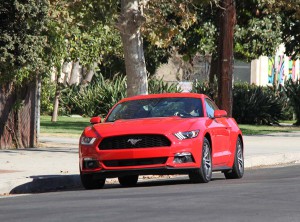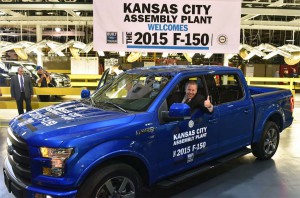What started off as a new engine entry blanketed in skepticism is now one of Ford Motor Co.’s biggest success stories. The EcoBoost family of engines is going to hit 1 million in annual sales for the first time this year.
Introduced in 2009 as a 3.6-liter V6 for the Taurus SHO, the family has grown dramatically as Ford has pitched the turbocharged engines as greener than the competition: smaller engines using less gas but delivering the power and performance of larger models.
While many scoffed at the claims made by the automaker about the performance and durability of the EcoBoost, the engines have lived up their billing. Right now, there are seven different EcoBoost engines and another is expected to arrive sometime next year for the Ford Escape.
The automaker’s sold nearly 820,000 EcoBoosts this year, which is a 46% increase compared with last year’s results. For 2015, EcoBoost is available on every non-hybrid light-duty passenger vehicle in Ford’s U.S. lineup.

The EcoBoost-equipped Mustang puts out 310 horsepower. The maker has sold nearly 40,000 units in this year.
The technology combines smaller engines with turbocharging, direct injection and variable valve timing – as well as Ford’s proprietary EcoBoost engine management software – to bring customers fuel efficiency along with the performance they expect, according to Ford.
“Ford EcoBoost delivers great performance along with the capability of impressive fuel efficiency,” said Erich Merkle, Ford sales analyst. “Ford leadership in clean gasoline turbocharged engine technology is paying dividends as evidenced by EcoBoost sales growth.”
(China auto sales post massive October rebound. For more, Click Here.)
Perhaps the biggest testimony to the acceptance to the smaller, yet more powerful engines is the take rates on two of Ford’s most prominent vehicles: F-150 and Mustang. This year, the company has sold 210,239 EcoBoost-powered F-150s, accounting for 64% of all sales.
The 2.7-liter four cylinder EcoBoost, which comes with standard Auto Start-Stop, is new for the 2015 F-150 and puts out 325 horsepower and 375 ft-lb of torque while the 3.5-liter V6 EcoBoost is a little more robust at 365 hp and 420 ft-lb.
The Mustang, which boasts an optional 2.3-liter four cylinder putting out 310 hp and 320 ft-lb of torque, sold 39,420 EcoBoost-equipped models this year: it’s first year with the engine.
“This EcoBoost engine delivers where a Mustang driver expects it to – with a broad, flat torque curve that pours out when you stand on it for easy passing or hustling down a twisty road,” said Dave Pericak, Mustang chief engineer.
(Click Here for details about GM plugging in a potential game changer.)
The best seller, by percentage, is the Escape with 78% of the crossovers sold with one under the hood.
Ford’s global EcoBoost engine family now includes the 1.0-liter three-cylinder; 1.5-liter, 1.6-liter, 2.0-liter and 2.3-liter four-cylinder engines; and the powerful 2.7-liter and 3.5-liter V6 engines. A Lincoln-exclusive 3.0-liter V6 debuts in 2016 for the new Continental.
Ford believes strongly in the powerplant and is investing heavily in it, not just in the U.S. but also globally. Ford recently invested nearly $200 million at its Cleveland engine plant, which makes the 2.0-liter twin-scroll EcoBoost now available on the Edge. Production of that engine began earlier this year.
In March 2014 Ford announced a $500 million investment in its Lima, Ohio, engine plant to support production of a new, small six-cylinder EcoBoost engine for its 2015 F-150. The money went toward renovating 700,000-square feet at the plant and for the installation of a flexible engine assembly system.
(To see more about German, U.S. regulators cracking down on emissions testing, Click Here.)
And in 2013, Ford doubled production capacity at its Cologne, Germany, plant to more than 1,000 EcoBoost engines a day to meet high demand for the 1.0-liter now powering one in five Ford vehicles sold in Europe.


Cool, but I am still skeptical as to engine life, and wonder if there is any data to support Ford’s claims. That 1.0 liter 3-cylinder woud be an awesome engine for a motorcycle, go-kart, or lawn tractor.
Ford EcoBoost with direct injection evens cylinder pressure throughout the power stroke and eliminates detonation, greatly increasing engine longevity. Combine that with Ford’s proven record of bulletproof engines – ask any limo/taxi owner about the million km 4.6L or any punk about the abuse they’ve given their 5L! Ford’s typically endure service neglect that would quickly finish an import.
It’s a no brainer…
Andy-
Let’s not get carried away with advertising hype and perceptions… LOL
The excellent engine life that Ford and other U.S. auto makers are known for is typically with low revving V-8 engines. If you aren’t aware Ford’s 2.3L Turbo and Chrysler’s 2.2/2.5L Turbo and the Chevy Vega engines were known for being worn out and blowing massive oil out the tailpipes at ~50,000 miles of normal consumer service.
The new EcoBoost engines are more refined Turbo engines than Ford has produced in the past, IME. Ford spent a lot of time conducting durability testing some of which they have used in their advertising. They however do similar durability testing with all new engine designs and still sold a lot of 2.3L Turbo engines that were worn out at 50,000 miles.
When you replace a low revving V-8 engine with a higher revving boosted engine, you immediately subject the internals of the engine to higher physical and thermal loads compared to the low revving V-8 engines. In order to produce similar usable power to the V-8 engines the engine operates in a boosted state the majority of time which means higher stress that leads to earlier component fatigue. In order to achieve acceptable performance and durability from a smaller more highly stressed engine premium engine materials, designs and construction techniques must be employed.
The jury is still out on the EcoBoost engines. Hopefully Ford has gotten everything right and these will prove to be excellent, reliable durable engines. It’s far too early to reach a decision on these engines or the aluminum F150 bodies. Five to ten years from now we should have more definitive results to replace speculation.